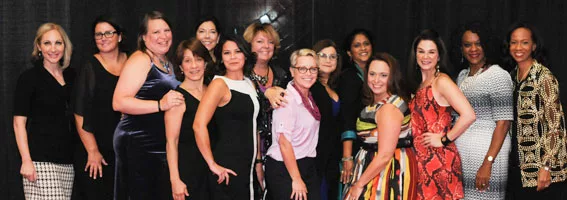“Our Time Is Now” is more than a saying that inspired the theme of the 2019 National Women’s Business Conference hosted by NAWBO. It’s a movement, backed by a force of entrepreneurial women who have dreamed big, forged ahead, conquered challenges and achieved goals—and we’re not stopping yet. Here are five reasons why our time really is now and we’re doing something about it.

1
We’re helping women—and the economy—thrive. Women-owned businesses (WOBs) represent one of the country’s fastest-growing business segments, with a 45% growth between 2007 and 2016, compared with a 9% growth in all businesses. In fact, WOBs launch every day in the United States. According to a report from the Small Business Administration’s Office of Advocacy, 36% of all businesses are women-owned and boosting the economy.
- Currently, more than 8.4 million people are employed by a WOB.
- WOBs account for 12% of all sales and 15% of employment.
- WOBs generate $264 billion in payroll.
- WOBs are gaining ground with 59% of Black/African-American businesses and 44% of Hispanic businesses owned by women, versus 32% of non-Hispanic white businesses.
The impressive growth of WOBs brings to the market new products, services and technology—all of which fuel our economy through increased spending and tax revenue.
2
Women are key contenders and making history in Washington, DC. Women serve in prominent positions where they have the power to help transform public policy in ways that benefit, support and propel women business owners.
- In 2019, nine women are serving as governors in the U.S.
- As of January 2019, there are 102 women in the U.S. House of Representatives. That accounts for 23.4% of the total of U.S. Representatives.
- There are 25 women serving in the United States Senate, 17 Democrats and eight Republicans. That’s the highest proportion of women serving as U.S. Senators in history.
- As of February 2019, 295 women are serving as mayors in cities with populations of 30,000 or more. That’s 20.9% of all U.S. mayors.
3
We’re advocating for more access to capital. It was in 1988 when women were first able to solely apply for a bank loan. Before then, a male co-signer was required, which limited female entrepreneurs’ access to capital. While entrepreneurial women are now able to apply for bank loans, they still receive about 45% less money than their male peers, according to a study released by Biz2Credit. Women continue to advocate for the financial means necessary to help their businesses thrive.
4
We’re taking our place in the boardroom. Women have taken their place on the Fortune 500 List since it was first published in 1955. The magazine compiles the list by ranking 500 of the largest corporations in the U.S. by total revenue. In 2017, there were a record-breaking number of 32 female CEOs on the list. Women also made gains in The Wall Street Journal’s 2016 Compensation Report. For the first time in the study’s 28-year history, three of the 10 highest-paid chief executives of S&P 500 companies were women (Meg Whitman at Hewlett Packard Enterprise Co., Virginia Rometty at International Business Machines Corp. and Indra Nooyi at PepsiCo.).
5
We’re mentoring upcoming female leaders. The United States is seeing a record number of women graduating college and entering the workforce, yet the momentum slows when advancing to senior positions. As more women are appointed to leadership roles, they have the opportunity to mentor those who are following in their footsteps. And the benefits are vast. Women who are mentored by women can better navigate office politics, gain confidence to speak up when it matters most and enjoy key networking opportunities that can propel them up the corporate ladder. In fact, mentees with female mentors are more likely to be promoted, states a study in the Journal of Applied Psychology. What’s more, the growing number of WOBs have the power to change what women earn in their respective companies.

